
Marine angelfish are perciform fish of the family Pomacanthidae. They are found on shallow reefs in the tropical Atlantic, Indian, and mostly western Pacific Oceans. The family contains seven genera and about 86 species. They should not be confused with the freshwater angelfish, tropical cichlids of the Amazon Basin.

Scorpaena cardinalis, the eastern red scorpionfish, grandfather hapuku, cardinal scorpionfish, Cook's scorpionfish, Cook's rockcod, Kermadec scorpionfish, Northern scorpionfish, red scorpion fish, red scorpion-cod or Sandy-bay cod, is a species of marine ray-finned fish belonging to the family Scorpaenidae, the scorpionfishes. It is found in the southwestern Pacific Ocean.

The clearfin lionfish, also called the tailbar lionfish, radiata lionfish, fireworks fish or radial firefish, is a carnivorous, ray-finned fish with venomous spines belonging to the family Scorpaenidae, the scorpionfishes and lionfishes. This species lives in the Indian and western Pacific Oceans. This is the only lionfish species which has spines without any markings. It can also be recognized by the pair of horizontal white stripes on its caudal peduncle.

The painted greenling is a species of marine ray-finned fish belonging to the family Zaniolepididae, which includes this species and the combfishes. It is endemic to the northeast Pacific Ocean. It is the only species in the genus Oxylebius.

The Japanese angelfish or Japanese pygmy angelfish, is a species of marine ray-finned fish, a marine angelfish belonging to the family Pomacanthidae. It is found in the western Pacific Ocean.

The mangrove red snapper, also known as mangrove jack, grey snapper, creek red bream, Stuart evader, dog bream, purple sea perch, red bream, red perch, red reef bream, river roman, or rock barramundi, is a species of marine ray-finned fish, a snapper belonging to the family Lutjanidae. It has a wide Indo-Pacific range and has recently been recorded in the eastern Mediterranean Sea.
The Japanese snapper is a species of marine ray-finned fish, a snapper belonging to the family Lutjanidae. It is native to the Western Pacific Ocean.
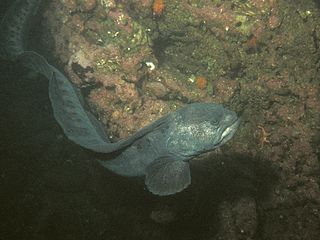
The wolf eel is a species of marine ray-finned fish belonging to the family Anarhichadidae, the wolf fishes. It is found in the North Pacific Ocean. Despite its common name and resemblance, it is not a true eel. It is the only species in the monotypic genus Anarrhichthys.

Zaniolepis, the combfishes, is a genus of marine ray-finned fish, it is one of two genera in the family Zaniolepididae. These fishes are native to the eastern Pacific Ocean. Z. frenata that was a source of food to the Native American inhabitants of San Nicolas Island off the coast of southern California, United States during the Middle Holocene.

Chrysiptera hemicyanea, known commonly as the azure damselfish, azure demoiselle, half-blue demoiselle, and yellow-dipped damsel, is a species of damselfish.

Acanthurus nigrofuscus, the brown surgeonfish, blackspot surgeonfish, brown tang, dusky surgeon, lavender tang or spot-cheeked surgeonfish, is a species of marine ray-finned fish belonging to the familyAcanthuridae, which includes the surgeonfishes, unicornishes and tangs. This species is a common and abundant fish occurring across a wide Indo-Pacific range.
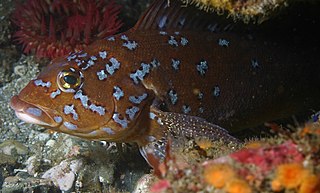
The kelp greenling is a species of marine ray-finned fish belonging to the family Hexagrammidae, the greenlings. It occurs in the eastern Pacific Ocean
Malacoctenus hubbsi, the redside blenny, is a species of labrisomid blenny native to the Gulf of California extending to the Pacific coast of southern Baja California. It is found in rocky areas at depths of from 1 to 4 metres. This species can reach a length of 9 centimetres (3.5 in) TL. The specific name honours the American ichthyologist Clark Hubbs (1921-2008).

Clinocottus acuticeps, the sharpnose sculpin, is a species of marine ray-finned fish belonging to the family Cottidae, the typical sculpins. This sculpin is found in the eastern Pacific Ocean.
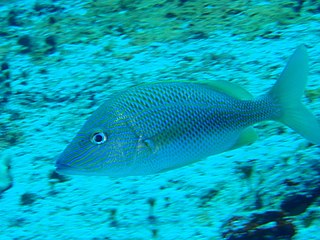
Haemulon plumierii, the white grunt or common grunt, is a species of ray-finned fish in the family Haemulidae native to the western Atlantic Ocean. It grows to a length of about 30 cm (12 in) and is a silvery-cream color, with narrow yellow and blue longitudinal stripes, but can modify its color somewhat to match its surroundings. It is closely related to the bluestriped grunt and the French grunt, and often schools with these species. It feeds on shrimp, other crustaceans, annelids, and mollusks, and is preyed on by larger piscivores such as barracuda and shark. It is sometimes caught by anglers as a game fish, and its flaky white flesh can be eaten. It is also a popular aquarium fish.

Hexagrammos is a genus of marine ray-finned fishes belonging to the family Hexagrammidae, the greenlings. These fishes are found in the north Pacific Ocean.

Pleurogrammus is a genus of ray-finned fishes belonging to the family Hexagrammidae, the greenlings, known as Atka mackerels. These fishes are found in the northwestern Pacific Ocean.
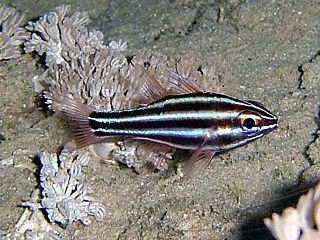
Ostorhinchus cookii, common names Cook's cardinalfish, Cook's soldierfish, blackbanded cardinal, blackbanded cardinalfish, is a species of marine fish in the family Apogonidae.

Pristipomoides multidens, the goldbanded jobfish or goldbanded snapper, is a species of ray-finned fish, a snapper belonging to the family Lutjanidae. It is found in the Indian and Pacific Oceans.
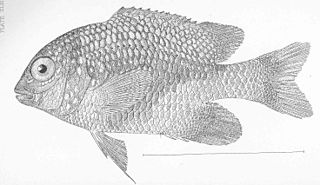
Microspathodon bairdii, the bumphead damselfish, is a species of ray-finned fish from the family Pomacentridae. It is found in the eastern Pacific Ocean.



















